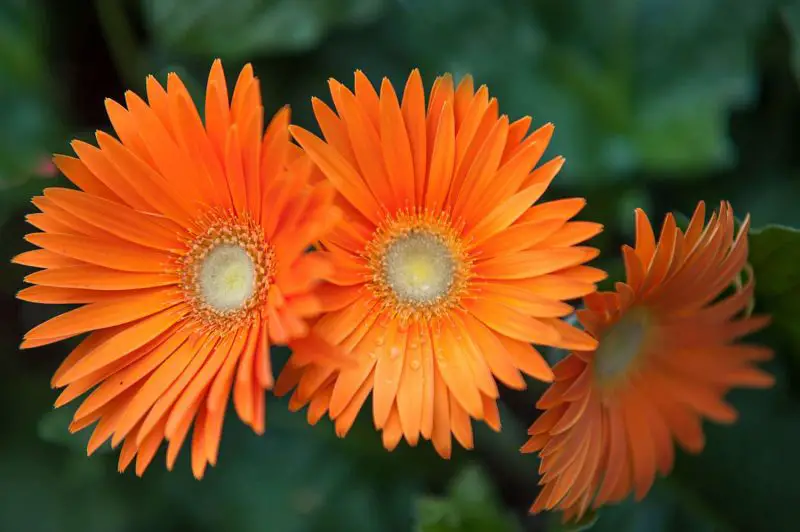Gerbera daisies are beloved for their cheerful, daisy-like blooms and vibrant colors that brighten up any space—indoors or out. But if you’re a cat owner, you might pause before placing them on your windowsill or in your garden. The question naturally arises: are gerbera daisies toxic to cats?
This guide dives deep into everything you need to know about gerbera daisies and feline safety. Whether you’re decorating your home or planting a pet-friendly garden, we’ll help you make informed decisions to keep both your flowers blooming and your cat safe.
Understanding Gerbera Daisies and Their Appeal

Gerbera daisies (Gerbera jamesonii) are among the most popular flowering plants in the world, prized for their bold, colorful blooms and long vase life. Available in a wide spectrum of hues—from bright orange and deep red to soft pink, yellow, and white—these flowers bring an immediate burst of joy to gardens, floral arrangements, and indoor decor. Their large, symmetrical petals and sturdy stems make them both striking and versatile.
Native to South Africa, gerberas thrive in warm climates and well-drained soil. They belong to the Asteraceae family, which includes sunflowers and daisies, and they share the same sunny, welcoming appearance. Their low-maintenance nature makes them ideal for beginner gardeners, while their eye-catching beauty attracts everyone from professional florists to pet owners seeking cheerful greenery. Understanding their charm is the first step in deciding how to incorporate them safely into a cat-friendly home.
Are Gerbera Daisies Toxic to Cats?
Official Classification by ASPCA
According to the American Society for the Prevention of Cruelty to Animals (ASPCA), Gerbera daisies are officially recognized as non-toxic to cats. This classification provides peace of mind to pet owners, confirming that the plant is not associated with toxic compounds that could harm felines. The ASPCA’s database of toxic and non-toxic plants is widely respected by veterinarians and animal welfare experts, making it a reliable resource for identifying safe greenery for homes with pets. In essence, keeping Gerbera daisies indoors or in the garden poses no known toxic threat to your cat’s health.
What Being Non-Toxic Really Means
Non-toxic doesn’t always mean entirely harmless. While Gerbera daisies are not chemically poisonous, they are still foreign to a cat’s digestive system. A curious bite or two may not result in serious issues, but it could still lead to mild, temporary discomfort. Non-toxic simply indicates that the plant lacks harmful substances such as alkaloids or saponins that typically cause toxicity in cats. Still, some cats have sensitive stomachs or behavioral quirks that make them more prone to chewing on plants, and any ingestion—no matter how benign—can sometimes provoke a reaction.
Potential Risks of Overconsumption
Cats that consume large quantities of Gerbera daisies might exhibit signs of gastrointestinal irritation, even though the plant isn’t toxic. Overconsumption could lead to symptoms like excessive drooling, vomiting, soft stools, or noticeable changes in behavior such as decreased energy or hiding. These symptoms are usually short-lived and resolve as the plant material moves through the cat’s digestive system. However, if the symptoms last more than a day or if your cat refuses to eat or drink, it’s best to contact a veterinarian for evaluation. Prevention is key, so keeping Gerbera daisies out of your cat’s immediate reach can minimize unnecessary exposure and worry.
Why Cats Chew on Plants
Signs of Plant-Related Discomfort in Cats
Gastrointestinal Symptoms
After chewing on houseplants, cats may exhibit a range of gastrointestinal symptoms—even when the plant isn’t classified as toxic. Vomiting is the most common, often caused by mechanical irritation from leaf fibers or a natural reflex to purge foreign material. Diarrhea and excessive drooling can also occur, indicating your cat’s digestive system is responding negatively to the ingested plant matter. These symptoms typically arise within a few hours and may resolve on their own, but it’s essential to monitor their duration and severity, as persistent symptoms could signal something more serious.
Behavioral Changes
Cats often signal discomfort through subtle behavioral shifts. A cat that has nibbled on a plant and is feeling unwell may suddenly become withdrawn, sleep more than usual, or hide in unusual places. A decline in appetite or refusal to drink water could also suggest that the cat is experiencing nausea or abdominal discomfort. Even with non-toxic plants like Gerbera daisies, these signs should be taken seriously. Behavioral changes are often the first indicators that something isn’t right, and early detection can make a significant difference in treatment outcomes.
When to Call the Vet
If your cat’s symptoms do not subside within 24 hours or worsen—such as repeated vomiting, signs of dehydration, or labored breathing—it’s time to consult your veterinarian. While Gerbera daisies are generally considered safe, every cat is different, and individual sensitivities can lead to unexpected reactions. Furthermore, chewing on plants can sometimes lead to secondary complications like choking, bacterial contamination, or interaction with pesticide residues. If you’re unsure which plant your cat may have ingested, or you notice any unusual swelling or neurological symptoms, seek veterinary help immediately.
Safe Gardening with Cats in Mind
Placing Gerbera Daisies Out of Reach
Strategically placing your Gerbera daisies can significantly reduce the risk of cat-plant interactions. Consider using plant stands or wall-mounted shelves in areas your cat doesn’t usually explore. Window boxes or balcony containers that are closed off with mesh or glass can also offer both sunlight and protection. If you keep plants indoors, opt for sunlit rooms with doors that can be closed when unsupervised. In multi-cat households, elevation alone may not be enough—consider placing plants in rooms that are entirely off-limits to your pets to eliminate temptation altogether.
Training and Behavioral Tools
Training a cat requires patience, but it’s possible with a multi-pronged approach. Start by firmly saying “no” and redirecting your cat each time they show interest in your plants. You can reinforce this with clicker training or reward-based systems using treats. Pet-safe citrus or bitter-apple sprays applied to leaves deter many cats due to their unpleasant taste or scent. Adding cat grass or catnip to your plant collection gives your feline a safe alternative to chew on and can reduce the allure of your daisies. Enrich your cat’s environment with interactive toys, scratching posts, or puzzle feeders to keep their minds and paws occupied.
Alternatives to Live Plants
If keeping live plants becomes too challenging, artificial Gerbera daisies offer a worry-free solution. Modern faux plants can look incredibly realistic and are often made of soft, flexible materials. However, it’s still important to choose products made from non-toxic plastics or fabrics in case your cat decides to investigate with its teeth. Avoid artificial plants with wire components that could pose a risk if chewed. You can also decorate with dried flowers or botanical prints for a plant-inspired aesthetic that poses zero threat to curious pets.
Creating a Cat-Friendly Garden with Gerberas
Helping Friends Choose Pet-Safe Flowers
As a pet lover and garden enthusiast, you have the power to influence others in making safer choices for their homes and gardens. When talking with friends, family, or members of gardening clubs, mention that Gerbera daisies are not only beautiful but also safe for cats. Many people are unaware that common flowers like lilies or tulips can be toxic. By recommending non-toxic alternatives such as Gerberas, snapdragons, or marigolds, you help prevent accidental poisoning and promote healthier homes.
Encourage others to consult reputable resources like the ASPCA’s toxic and non-toxic plant list, especially before adding new greenery indoors or outdoors. For households with pets, it’s always better to double-check plant safety rather than take risks. Even one informed conversation can make a meaningful difference.
Supporting Local Nurseries and Pet Stores
Supporting nurseries and stores that care about pet safety helps grow a more responsible gardening community. Choose to buy from businesses that clearly label their plants, especially those marked as “pet-safe” or “non-toxic.” Ask staff if you’re unsure about a species—they may provide safer alternatives or guide you to proper educational materials.
Some pet stores go a step further by offering cat-friendly plants like wheatgrass or catnip. Including these in your shopping not only enriches your cat’s environment but also encourages local businesses to continue stocking safe and enriching plant varieties. Your purchases and questions signal demand for responsible options.
Advocating for Plant Safety Awareness
You don’t need a large audience to make an impact—sharing your own experience on social media, pet forums, or gardening blogs can educate countless people. Post photos of your cat enjoying your Gerbera-filled garden, or write a short post about why you chose non-toxic flowers. Mention the risks associated with popular but dangerous plants, and suggest easy swaps.
Consider joining online communities focused on pet-friendly gardening where you can trade tips, ask questions, and support others trying to do the same. Raising awareness in these small ways builds a stronger network of mindful pet owners and plant lovers who value both beauty and safety.
Conclusion: A Harmonious Home with Gerbera Daisies and Cats
Gerbera daisies are not toxic to cats, making them a beautiful and safe choice for households with feline companions. While occasional nibbling may cause mild digestive discomfort, the risks are minimal compared to toxic plant varieties. By understanding your cat’s behavior, using thoughtful placement, and maintaining a stimulating environment, you can enjoy the vibrant charm of Gerbera daisies without worry. Education, prevention, and responsible gardening will ensure both your flowers and your furry friends thrive together.
FAQ About Gerbera Daisies and Cat Safety
Are Gerbera daisies safe for cats to touch and smell?
Yes, Gerbera daisies are considered non-toxic to cats, according to the ASPCA. It’s perfectly safe if your cat brushes against them or sniffs them. The foliage and blooms won’t harm your pet through casual contact. However, always monitor for excessive chewing, as ingesting any plant material—even non-toxic ones—may cause mild stomach upset.
What should I do if my cat chews on Gerbera daisies?
While Gerbera daisies are not poisonous, some cats might still experience minor gastrointestinal discomfort after chewing large amounts of the leaves or petals. If you notice symptoms like vomiting, diarrhea, or unusual behavior, it’s best to contact your veterinarian for advice. In most cases, the symptoms are mild and pass quickly.
How can I discourage my cat from chewing on plants—even safe ones like Gerberas?
You can deter your cat by using natural repellents like citrus peels around the plant base or spraying a diluted citrus-scented solution (cats dislike citrus). Providing alternatives such as cat grass or catnip will redirect their attention. Positioning your Gerbera daisies in spots that are less accessible to your cat, such as elevated shelves or hanging baskets, can also help.
Are Gerbera daisies safe for homes with kittens or cats with health issues?
Yes, Gerbera daisies are generally safe for all cats, including kittens and those with sensitive health conditions. However, it’s always a good idea to monitor your cat’s interactions with new plants. Curious kittens are more likely to chew, so offer safe distractions like interactive toys or approved chewable greenery.
What other flowers can I plant alongside Gerberas that are also safe for cats?
There are many beautiful, cat-safe companion flowers you can pair with Gerbera daisies, including snapdragons, marigolds, roses, and zinnias. These plants add vibrant color to your garden without compromising your cat’s safety. When selecting companion plants, always double-check their toxicity status through trusted sources like the ASPCA’s online plant database.
Conclusion: Gerbera – A Bloom of Joy for Every Home
Gerbera daisies are more than just pretty flowers—they are vibrant symbols of joy, resilience, and cheer that light up any corner of your home or garden. Whether you’re growing them as perennials in warm climates or nurturing them indoors as potted companions, these blooms reward your care with stunning color and uplifting energy.
Caring for Gerbera daisies, especially in a pet-friendly home, is a beautiful balance of love, attention, and gentle protection. With the right knowledge and thoughtful routines, you’ll not only enjoy longer-lasting blooms but also create a safe, happy space where both your plants and your furry companions thrive. So go ahead—embrace the color, cultivate the joy, and let Gerbera daisies become a lasting part of your home’s heartbeat.






